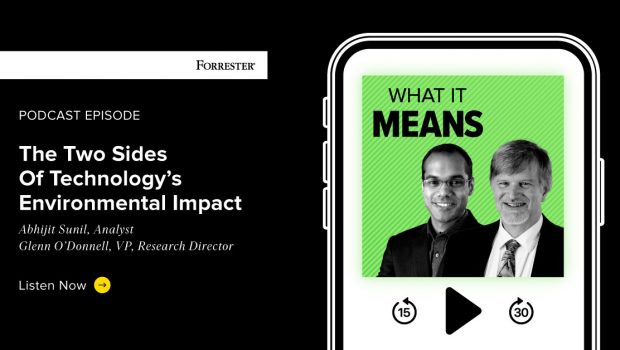The Two Sides Of Technology’s Environmental Impact · Forrester
https://www.ispeech.org/text.to.speech
Featuring:
Abhijit Sunil, Analyst and Glenn O’Donnell, VP, Research Director
Show Notes:
There are two sides to every story. In this episode, our analysts debate the two sides to the story of emerging technology’s impact on the environment. Analyst Abhijit Sunil and VP, Research Director Glenn O’Donnell review three key technology areas, discuss the environmental benefits and risks of each.
Appropriately, the first area of technology that gets debated is semiconductors (appropriate, because they power so many other emerging technologies). Sunil says new circuitry and power management functions in chips can be used to dramatically reduce power consumption in emerging technologies, so they have a positive impact on environmental efforts. Yet unfortunately, O’Donnell notes, the semiconductor manufacturing process to support the increased demand for chips is having a negative environmental impact. “Everyone gets excited about electric cars as opposed to fossil-fuel-burning cars, but electric cars need a lot of chips and a lot of power, and that does not come as a freebie” to the environment, he points out.
The analysts next debate the environmental impact of artificial intelligence and machine-learning technology. Sunil emphasizes that AI can be used to redirect excess power in the grid to reduce overall energy usage, a clear win for the planet. Also, he says AI can predict extreme weather events or maintenance needs for manufacturing, which can reduce energy demand. But on the other hand, the computing power required to run AI applications uses a lot of electricity and generates a lot of heat that needs to be cooled, says O’Donnell.
The third area that gets debated relies heavily on the first two. Edge computing and internet-of-things technologies use a lot of both semiconductors and AI. Sunil says IoT devices can help collect vital data for tracking and optimizing the sustainability journey of products, and smart city and building solutions that improve sustainability are powered by edge and IoT. But as these technologies increase in demand, O’Donnell points out, more devices and batteries will eventually need to be disposed of, creating more electronic waste.
While the debate during the episode opens up a lot of questions for technology executives, the episode wraps with Sunil providing some clear takeaways for organizations looking to minimize the impact of emerging technology on their sustainability efforts.








Gloss